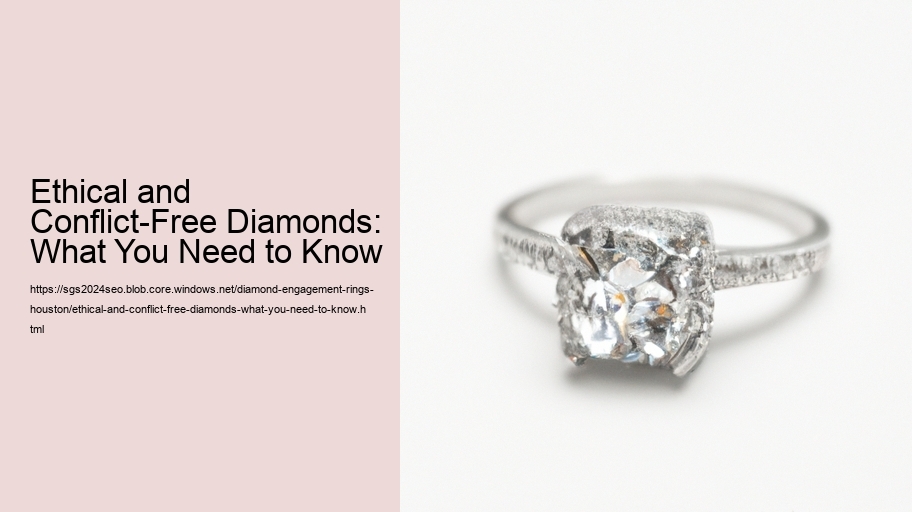Ethical and Conflict-Free Diamonds: What You Need to Know
undefined undefined undefined.
Diamonds have long been cherished as symbols of love, commitment, and luxury. However, beneath their sparkling exterior, these precious stones have a history that is often marred by conflict, exploitation, and environmental degradation. The term "ethical and conflict-free diamonds" has emerged as a beacon of hope for conscientious consumers who wish to enjoy the beauty of diamonds without contributing to the darker aspects of the industry. Understanding what ethical and conflict-free diamonds mean, and why they matter, is essential for anyone looking to make informed and responsible choices.
The Dark History of Diamonds
The allure of diamonds has not always been innocent. In the late 20th century, the world became acutely aware of "blood diamonds" or "conflict diamonds"-stones mined in war zones and sold to finance armed conflict against governments. The most notorious examples come from African countries like Sierra Leone, Angola, and the Democratic Republic of Congo, where rebel groups used diamond revenues to fund brutal civil wars. The human cost was devastating: forced labor, violence, and countless lives lost.
The Kimberley Process: A Step Forward
In response to the global outcry, the Kimberley Process Certification Scheme (KPCS) was established in 2003. This international initiative aims to prevent conflict diamonds from entering the mainstream market by certifying the origins of rough diamonds. While the Kimberley Process has made significant strides in reducing the flow of conflict diamonds, it is not without its flaws. Critics argue that the certification process can be circumvented and that it does not address broader ethical concerns such as environmental damage, labor rights, and community welfare.
Beyond Conflict-Free: Ethical Diamonds
While the Kimberley Process focuses on conflict prevention, ethical diamonds go a step further. Ethical diamonds are sourced with a commitment to social and environmental responsibility. This means that the entire supply chain-from mining to cutting and polishing-is scrutinized to ensure fair labor practices, safe working conditions, and minimal environmental impact. Ethical diamond companies often work closely with local communities to support economic development and social programs, ensuring that the benefits of diamond mining are shared more equitably.
Lab-Grown Diamonds: A Sustainable Alternative
One of the most exciting developments in the quest for ethical diamonds is the rise of lab-grown diamonds. These diamonds are created in laboratories using advanced technology that replicates the natural diamond-growing process. Lab-grown diamonds are chemically, physically, and optically identical to mined diamonds, but their production has a significantly lower environmental impact. They do not involve mining, which means they avoid many of the ethical issues associated with traditional diamond extraction. For eco-conscious consumers, lab-grown diamonds offer a guilt-free alternative without compromising on quality or beauty.
Making an Informed Choice
For consumers looking to purchase ethical and conflict-free diamonds, there are several key considerations. First, research the retailer and their sourcing practices. Reputable jewelers often provide detailed information about the origin of their diamonds and their commitment to ethical standards. Look for certifications from recognized organizations such as the Responsible Jewellery Council (RJC) or Fairtrade Gold, which set stringent criteria for ethical practices in the jewelry industry.
Second, consider the environmental impact of your purchase. Diamonds that are mined with minimal ecological disruption and those that support restoration and conservation efforts are preferable. Lab-grown diamonds, as previously mentioned, are an excellent sustainable option.
Finally, think about the social impact of your diamond. Ethical diamonds should contribute positively to the communities where they are sourced. This means fair wages, safe working conditions, and investments in local infrastructure, education, and healthcare.
Conclusion
The journey towards ethical and conflict-free diamonds is an evolving one, driven by increased consumer awareness and demand for transparency and responsibility. By choosing ethical diamonds, consumers can enjoy the timeless beauty of these precious stones while supporting practices that respect human rights and the environment. As the industry continues to innovate and improve, the hope is that one day all diamonds will be free from conflict and mined with the utmost ethical integrity. Until then, informed and conscientious choices remain our most powerful tool for change.
